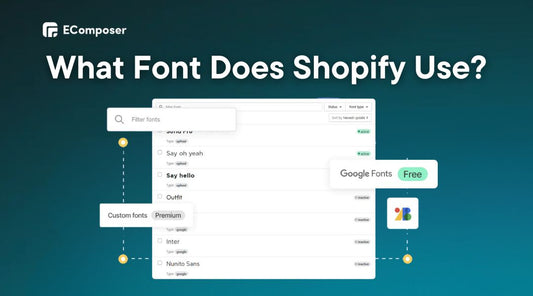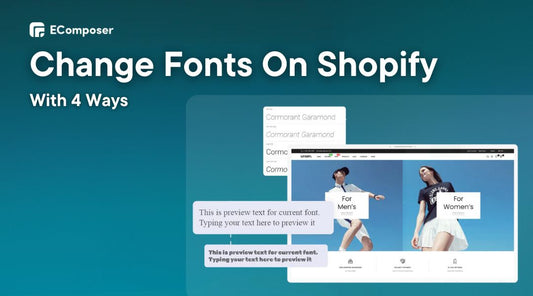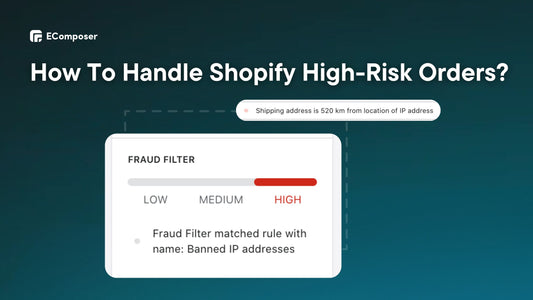How to Connect Shopify to Amazon? The Ultimate Guide

Table Of Contents
In today's ever-expanding e-commerce realm, the query of how to connect Shopify to Amazon holds significant weight for businesses seeking amplified market presence. The amalgamation of these two powerhouse platforms isn't merely a connection; it's a strategic move towards unlocking unparalleled sales opportunities and operational efficiencies.
Exploring the intricacies of this integration unveils a pathway to enhanced multichannel selling and broader consumer reach, reshaping the way businesses thrive in the digital marketplace.
Advantages of Connecting Shopify to Amazon
In the realm of e-commerce, the decision to connect Shopify to Amazon can be a game-changer. This integration isn't merely about syncing platforms; it's about unlocking a realm of possibilities. Let's delve into the manifold advantages of amalgamating these giants.
Enhanced Sales Prospects
When you connect Shopify to Amazon, you effectively merge two expansive ecosystems, amplifying your product exposure manifold. Amazon, boasting millions of active users globally, serves as an invaluable gateway to reach a broader audience. Leveraging Amazon's robust search algorithm and user-friendly interface, your Shopify products gain unprecedented visibility.

This connectivity isn't just about accessing Amazon's user base; it's about strategically positioning your offerings within a platform known for its purchasing power. By aligning your Shopify store with Amazon's reach, you harness a significant advantage, exponentially multiplying the avenues for potential sales and cementing your presence in the competitive e-commerce landscape.
Broadened Data Understanding
Connecting Shopify to Amazon empowers businesses with a comprehensive data amalgamation, merging insights from two diverse yet complementary platforms. This integration doesn't just aggregate data; it unveils a goldmine of consumer behavior, preferences, and buying patterns.

By harmonizing information from Shopify and Amazon, merchants gain a 360-degree view of their customer base. Analyzing this amalgamated data becomes a strategic tool for refining marketing strategies, understanding consumer needs, and fine-tuning product offerings.
This holistic perspective enables tailored approaches, allowing businesses to optimize product placement, pricing, and marketing campaigns, thereby enhancing overall performance and staying ahead in a fiercely competitive market.
Comprehensive Approach to Multichannel E-commerce
The decision to connect Shopify to Amazon extends beyond mere integration; it revolutionizes the approach to multichannel e-commerce. This amalgamation creates a unified hub for managing sales across platforms, offering a streamlined operational workflow. Inventory management becomes a synchronized process, preventing overselling or discrepancies between Shopify and Amazon stock levels.
Additionally, order processing harmonizes, ensuring a consistent and efficient fulfillment mechanism. This seamless synchronization across platforms optimizes operational efficiency, reducing manual efforts and minimizing errors.
Businesses can redirect resources towards growth strategies, focusing on enhancing product quality, customer service, or exploring new market opportunities while ensuring a coherent and synchronized multichannel presence.
Reinforced Brand Image
The synergy established by connecting Shopify to Amazon is not merely transactional; it's strategic in shaping brand perception. The association with Amazon, a global e-commerce titan renowned for reliability and customer trust, becomes a cornerstone for reinforcing brand image.

Leveraging Amazon's established credibility and extensive reach inherently elevates the perceived trustworthiness of products showcased through Shopify. This alignment with a trusted marketplace bolsters brand recognition, instilling confidence in potential buyers.
Consequently, businesses stand to attract a broader audience drawn by the assurance and reputation associated with Amazon, thus fortifying their brand presence and amplifying their competitive edge in the market.
Additional Option
The strategic union of Shopify and Amazon opens an expansive realm of possibilities, presenting businesses with an additional avenue for sales diversification. This synergy transcends conventional boundaries, enabling merchants to venture into new markets seamlessly.
Connecting Shopify to Amazon empowers businesses to test diverse pricing strategies, adapt offerings to suit varied consumer preferences, and expand their reach across different demographics.
This leverages the amalgamated power to experiment, innovate, and tailor strategies for tapping into previously untapped consumer segments, thereby fostering growth and solidifying a resilient position in the evolving e-commerce landscape.
Read more: 15 Best Shopify Marketplace Apps Free & Paid
Prerequisites and Readiness for Connecting Shopify to Amazon
Operational Shopify Store
An operational Shopify store serves as the launchpad for success when connecting it to Amazon. It's not just about having a store; it's about having one that's finely tuned for customer engagement and sales conversion. If you haven’t had one yet, you can sign up for 3 months trial here.

Firstly, showcasing products effectively involves more than just listing them. It's about creating visually appealing product pages with high-quality images, detailed descriptions, and clear pricing. Additionally, organizing products into categories or collections can streamline navigation, making it easier for customers to find what they're looking for.
Smooth navigation is key. A well-structured and intuitive website layout ensures visitors can effortlessly explore different product categories, locate information, and complete purchases without encountering barriers or confusion.
Providing a hassle-free purchasing experience means optimizing for mobile responsiveness, secure payment gateways, and a straightforward checkout process. Minimizing steps from product selection to payment completion enhances user experience and reduces cart abandonment.
Functioning Amazon Seller Account
A functioning Amazon seller account is the gateway to unlocking the full potential of the connect Shopify to Amazon strategy.
Completing the setup involves providing accurate business information, verifying payment and banking details, and understanding the seller dashboard and tools. Moreover, adherence to Amazon's seller policies is non-negotiable. This entails complying with product listing guidelines, maintaining inventory accuracy, and ensuring prompt shipping and exceptional customer service.

A robust Amazon seller account, prepared and aligned with Amazon's policies, sets the stage for a seamless integration, allowing products from Shopify to seamlessly integrate and thrive within Amazon's vast marketplace.
Read more: 21 Best Amazon Product Research Tools
Consistent Currency Selection
Aligning currencies between both platforms eliminates confusion and streamlines the shopping experience for customers browsing products across Shopify and Amazon.
Maintaining a uniform currency format ensures transparency in pricing, preventing discrepancies or misunderstandings for customers during transactions. It's essential to configure product prices in the same currency across both Shopify and Amazon listings, facilitating a seamless transition for customers as they navigate between platforms.
For instance, a seller based in the United States operates a Shopify store where products are listed in US dollars (USD). When connecting Shopify to Amazon, they ensure that the prices listed on Amazon for the same products are also in US dollars.
This clarity in pricing not only fosters trust but also simplifies accounting and financial management, streamlining operations for businesses leveraging the integration of Shopify with Amazon.
Approval of Products
Amazon maintains strict criteria that items must meet before being listed for sale. This process involves adhering to Amazon's quality standards, category-specific requirements, and overarching policies.

(Source: https://www.anvilmediainc.com)
Each product must meet stringent quality benchmarks outlined by Amazon, ensuring consistency and reliability across all offerings. Furthermore, categorizing products accurately based on Amazon's guidelines is crucial for visibility and searchability within the platform.
Compliance with Amazon's policies regarding product descriptions, images, and customer satisfaction guarantees a smooth integration. This adherence is fundamental for products from Shopify to seamlessly blend into Amazon's marketplace, ensuring a successful and compliant selling experience.
Product Details
The essence lies in presenting products on Amazon with accuracy and completeness.
Each product requires a compelling title that is descriptive, keyword-rich, and aligned with Amazon's guidelines for maximum visibility. Detailed descriptions that highlight key features, benefits, and specifications are essential to inform and persuade potential buyers.
High-quality images from multiple angles, meeting Amazon's standards, enhance product visibility and credibility. Additionally, providing accurate specifications ensures customers have a clear understanding of what they're purchasing, minimizing confusion and reducing return rates.
Effective synchronization of these details from Shopify to Amazon optimizes product listings, increasing their appeal and discoverability within the Amazon marketplace.
Policy Adherence
Adhering to shipping standards outlined by Amazon ensures timely deliveries, fostering customer satisfaction and positive reviews. Meeting return policies, such as offering hassle-free returns within Amazon's guidelines, is vital for customer trust and retention.
Moreover, upholding exceptional customer service standards, promptly addressing queries and issues, contributes to a positive seller rating. Maintaining alignment between Shopify and Amazon in these policies and practices establishes credibility, trust, and longevity in the competitive Amazon marketplace.
How to connect Shopify to Amazon.
Step 1: Establishing a Shopify Store
Establishing a robust Shopify store serves as the foundation for linking Shopify to Amazon seamlessly. Craft a visually captivating, user-friendly, and optimized store using tools like EComposer, a valuable app for building engaging landing pages on Shopify.

Present products effectively with high-quality images and detailed descriptions within a well-designed storefront. A visually appealing store not only draws in customers but also sets the stage for effortless integration with Amazon, amplifying your potential for sales growth.
Step 2: Establishing an Amazon Seller Account
To begin, navigate to the Amazon Seller Central page and select the Sign Up option.
Creating an Amazon professional seller account involves either signing in with an existing Amazon seller account or crafting a new one by selecting "Create your Amazon account."

Prepare essential details for a seamless account setup:
- Business name and address
- Contact phone number
- Bank account particulars for payment reception
- Credit card details for subscription fees
- Store name
- Tax information and Taxpayer Identification Number (TIN)
Crafting an Amazon Seller Account sets the stage for seamless integration, allowing your Shopify store to tap into Amazon's vast marketplace effectively.
Step 3: Grasping Amazon’s Fulfillment Choices
Grasping Amazon's fulfillment options is crucial when connecting Shopify to Amazon. Amazon offers diverse fulfillment choices:
Fulfillment by Amazon (FBA): With FBA, Amazon manages storage, packaging, and shipping. Sellers send inventory to Amazon's warehouses, and when orders are placed, Amazon handles the delivery and customer service.
Fulfillment by Merchant (FBM): FBM allows sellers to manage their inventory and handle shipping directly. Sellers store products in their own facilities and manage the packing, shipping, and customer service aspects.
Understanding these options helps align your business's preferences. FBA offers convenience but involves fees, while FBM grants more control but requires efficient logistics. Choose the option that best suits your business model, considering factors like cost, scalability, and operational capabilities to ensure a seamless integration and efficient order fulfillment.
Step 4: Installing the Shopify Application for Amazon Linkage
Access the Shopify App Store: Log in to your Shopify account and navigate to the App Store.
Search for the Amazon Integration App: In the search bar, type keywords like "Amazon integration" or "Amazon app" to find relevant applications that facilitate Shopify and Amazon linkage.
Select an App: Browse through the available Amazon integration apps and choose one that suits your business needs, considering factors like features, pricing, and user reviews.

Install the Chosen App: Click on the app you've selected and follow the prompts to install it on your Shopify store. This typically involves granting permissions and authorizations for the app to access your store's data.
Configure the App: Once installed, configure the app settings as per your requirements. This may include syncing products, setting up pricing rules, managing inventory, and enabling order management between Shopify and Amazon.
Step 5: Synchronizing Products Across Shopify and Amazon
To synchronize products between Shopify and Amazon for consistent information and availability:
Use the Integration App: Access the Amazon integration app within your Shopify dashboard.
Product Selection: Choose the products you want to sync between Shopify and Amazon. This could involve selecting individual products or entire product categories.

Map Product Attributes: Match product attributes (titles, descriptions, images, variants, etc.) between Shopify and Amazon. Ensure the details align accurately for a seamless customer experience.
Initiate Sync: Start the synchronization process within the integration app. This action will trigger the transfer of selected product data from Shopify to Amazon or vice versa.
Monitor Progress: Track the synchronization process to ensure that product information transfers accurately. Check for any errors or inconsistencies that may arise during synchronization.
Review Listings: After synchronization, review product listings on both platforms. Ensure that the information, pricing, and inventory levels are consistent and correctly displayed across Shopify and Amazon.
Step 6: Supervising Inventory and Pricing
Many third-party integration apps on Shopify offer automated real-time synchronization of inventory and product details. This functionality ensures that product quantities remain consistent and updated simultaneously on both Amazon and Shopify platforms.
These apps provide a streamlined process to effortlessly manage and monitor inventory levels within the application itself. This empowers sellers to take proactive measures, such as preventing stockouts, avoiding overselling scenarios, and swiftly addressing any inventory-related concerns.
By leveraging this automated synchronization feature, sellers can maintain accurate inventory levels across multiple platforms, facilitating smoother operations and reducing the risk of inventory discrepancies or related issues.
Step 7: Executing Orders and Monitoring Shipment Status
Now that your Shopify products are showcased to Amazon customers, continuous monitoring of sales, inventory, and feedback is crucial. Optimize product listings, pricing, and fulfillment strategies to enhance performance on both platforms.
Regularly review Amazon's policies to ensure compliance while maximizing the Amazon integration app's features for selling strategies. This dual focus on policy adherence and leveraging integration app functionalities is key to success in the interconnected Shopify-Amazon marketplace.
Best Practices for Enhancing Amazon Listings
Writing Compelling and Keyword-Rich Content
Strategic integration of relevant keywords within product titles, bullet points, and descriptions optimizes visibility across Amazon's search algorithm.
Effective content optimization involves thorough research into keywords that resonate with the target audience. These keywords, strategically placed within the content, enhance the likelihood of products appearing prominently in Amazon search results.

Aligning the language with Amazon's search algorithm criteria is fundamental; it improves the chances of products ranking higher, consequently attracting more potential buyers to the listings.
This meticulous content alignment is pivotal for the successful integration of Shopify products into Amazon's marketplace, maximizing visibility and driving sales.
High-Quality Visual Representation
Visuals play a pivotal role in captivating potential buyers and influencing their purchase decisions on Amazon.
Images must be more than just clear; they should be visually enticing and informative, showcasing products from multiple angles, highlighting key features, and presenting details in high resolution. Customers rely heavily on these visuals as their primary reference point, shaping their perceptions and building trust in the product's quality and authenticity.
Ensuring a seamless connection between Shopify and Amazon demands that product images are optimized to meet Amazon's stringent image standards. Striking the right balance between visual appeal and informative representation maximizes the impact of product listings, enticing customers and driving conversions within Amazon's vast marketplace.
Detailed Product Information
Precise and comprehensive details, encompassing dimensions, materials, specifications, and usage instructions, serve as a trust-building cornerstone on Amazon.
Customers seek assurance and clarity in their purchasing decisions. Providing meticulous and accurate information mitigates uncertainties and builds buyer confidence. It's not merely about listing products but offering a transparent and informative narrative that aligns with Amazon's standards.
This alignment ensures that the product information seamlessly transitions from Shopify to Amazon, maintaining consistency and reliability across both platforms, thereby fostering trust and driving conversions in the competitive e-commerce landscape.
Customer Engagement and Reviews
Engaging customers promptly and responsively, addressing queries, and swiftly resolving any issues post-purchase are instrumental in nurturing a positive buyer-seller relationship.
Positive reviews not only amplify seller credibility but also significantly impact potential buyers' decisions. A higher volume of positive feedback signals trust and reliability, influencing purchasing choices within Amazon's competitive marketplace.

(Source:https://www.reddit.com)
Maintaining a consistent approach to customer engagement across both Shopify and Amazon channels strengthens brand perception and fosters customer loyalty, ultimately enhancing the integration's success and driving sales.
Performance Analysis and Adaptation
Analyzing sales data across both platforms enables understanding the performance variations and identifying top-performing products. Integrating this data helps in refining listings to maximize their impact within Amazon's marketplace.
Customer feedback serves as a compass guiding optimizations. It offers invaluable perspectives into customer preferences, enabling adjustments to listings for better resonance.
This adaptive strategy, synchronized between Shopify and Amazon, ensures that listings continuously evolve to meet the dynamic needs and preferences of the target audience, thereby enhancing visibility, conversions, and the overall success of the integration.
Top 3 Shopify-Amazon Integration Applications
Amazon Importer Spreadr App
Discover the Amazon Importer Spreadr App, a tool designed for effortless importing and synchronization of Amazon products, perfect for dropshipping or generating affiliate commissions. This app simplifies the process of seamlessly importing Amazon items into your Shopify store, whether you aim to drive Amazon Associate sales or manage the logistics of dropshipping.
You can leverage Amazon's robust services for shipping, returns, inventory management, and customer support, or take charge of shipping for your dropshipping business. By curating products that resonate with your brand or exploring new categories, you can broaden your audience appeal, boost SEO, and drive traffic through optimized product pages. Expand your product offerings to diversify revenue streams and scale your business effectively.

Key Features:
- Swift product import options: bulk import via CSV, quick import, or Chrome Extension.
- Customize buttons: 'Add to cart' or 'View on Amazon'.
- Automatic price and availability sync, opt for real-time synchronization.
- Keep full commissions with no deductions. Choose dropshipping if preferred.
- Additional features: auto-tagging, geo-localization, markup pricing, currency conversion, and more.
Pricing Plans:
- BASIC - $5/month:
- Unlimited product imports
- Amazon Button Link
- PRO - $10/month:
- Unlimited product imports
- Auto-sync
- Geo-localize
- Analytics
- Chrome Extension
- GOLD - $20/month:
- Unlimited product imports
- Auto-sync
- Geo-localize
- Analytics
- Chrome Extension
- Manual-sync
- Bulk actions
Rating: 4.8/5 based on 1,529 reviews
CedCommerce Amazon Channel
The CedCommerce Amazon Channel App is your go-to multichannel integration solution, seamlessly linking your Shopify store with the Amazon marketplace. This all-inclusive app simplifies the intricacies of managing both platforms, allowing effortless synchronization and management of products, inventory, and orders across Shopify and Amazon in a single, unified system. Elevate your eCommerce operations for a seamless and efficient business experience spanning both platforms.

Key Features:
- Connect multiple Amazon accounts (.eu, .ca, .com, etc.) to one Shopify store
- Manage FBA and FBM orders within Shopify
- Maximize advertising ROI and enhance conversion rates with Amazon marketing services
- Elevate Amazon listings and boost rankings using the AI-powered tool - Smart Lister (Beta)
- Enable local selling, leverage Amazon Buy Shipping, and manage it from Shopify (Beta)
Pricing Plans:
- FREE:
- Unlimited Listings
- Up to 50 Orders/month
- Connect Unlimited Amazon Accounts
- Free 24/7 support
- BEGINNER - $15/month or $165/year (8% savings):
- Unlimited Listings
- Up to 100 Orders/month
- Connect Unlimited Amazon Accounts
- All Listed Features Available
- Free 24/7 support
- STARTUP - $49/month or $539/year (8% savings):
- Unlimited Listings
- Up to 500 Orders/month
- Connect Unlimited Amazon Accounts
- All Listed Features Available
- Free 24/7 support
- SCALE - $89/month or $979/year (8% savings):
- Unlimited Listings
- Up to 1000 Orders/month
- Unlimited Amazon Accounts
- All Listed Features Available
- Free 24/7 support
Rating: 4.7/5 based on 940 reviews
Shopify Marketplace Connect
Shopify Marketplace Connect (formerly Codisto) offers a seamless pathway to sell across prominent global marketplaces such as Amazon, Walmart, eBay, and Etsy. This single app streamlines the integration of your Shopify product catalog with multiple marketplaces, facilitating the effortless management and synchronization of listings, orders, inventory, and performance assessment – all within Shopify's platform.

Key Features:
- Connect product listings to major marketplaces like Amazon, eBay, Walmart, and Etsy
- Manage listings, orders, and inventory in Shopify with real-time synchronization across marketplaces
- Flexible fulfillment options supporting integrated channel strategies
- Unlimited marketplace account connections for supported platforms
- Sell across various marketplace regions and categories with integrated currency conversion
Pricing Plans:
- Free Plan:
- First 50 marketplace-synced orders/month free
- 1% fee per additional synced order, capped at $99/month
- Basic Plan - $25.00 USD/month
- For individuals & small businesses
- Basic reports
- Up to 1,000 inventory locations
- 2 staff accounts
- Shopify Plan - $65.00 USD/month for 3 months:
- For small businesses
- Professional reports
- Up to 1,000 inventory locations
- 5 staff accounts
- Advanced Plan - $399.00 USD/month for 3 months:
- For medium to large businesses
- Custom report builder
- Up to 1,000 inventory locations
- 15 staff accounts
Rating: 4.3/5 based on 1360 reviews
Read more:
15 Best Shopify Marketplace Apps
14 Best Shopify Dropshipping Apps
Upcoming Trends in The Way We Connect Shopify to Amazon
The integration between Shopify and Amazon is on a trajectory of constant evolution, with an array of emerging trends shaping the future of this connection.
Enhanced Automation and Real-Time Updates: Anticipate refined synchronization capabilities that offer seamless real-time updates between Shopify and Amazon. Advanced automation will streamline processes, ensuring accurate and instant data synchronization.
Optimized Inventory Management: Future trends will spotlight improved inventory forecasting tools. These innovations will empower businesses to efficiently manage inventory across platforms, enhancing planning strategies and minimizing stock-related issues.
Data-Driven Insights: Expect more robust data analytics and reporting features. These advancements will provide sellers with deeper insights, enabling informed decisions driven by comprehensive data analysis.
Expansion to Emerging Channels: The future holds integration expansion beyond Amazon, encompassing emerging marketplaces and channels. This evolution will diversify sellers' reach, leveraging additional platforms beyond Amazon.
Sustainability and Ethical Commerce: There's a growing emphasis on sustainable and ethical practices. Consumers seek eco-friendly products, and businesses integrating these values into their offerings will likely gain favor.
Regulatory Compliance and Privacy: Increasing focus on data privacy regulations and consumer protection will shape integration strategies. Adhering to compliance measures and ensuring data security will remain a priority.
The evolution of Shopify-Amazon integration opens doors to unparalleled opportunities for online sellers. By embracing these forthcoming trends and leveraging this integration's capabilities, businesses can harness expansive growth prospects and navigate the dynamic e-commerce landscape with agility and innovation.
FAQs
Will customer reviews from Amazon reflect on my Shopify store?
Reviews specific to Amazon listings usually remain on Amazon. However, satisfied customers might cross-visit your Shopify store, potentially leaving reviews there.
Can I set different pricing or promotions for products on Amazon compared to my Shopify store?
Yes, certain integration apps enable setting different pricing or running exclusive promotions for products listed on Amazon while maintaining separate pricing on Shopify.
Are there any prerequisites or specific requirements for integrating Shopify with Amazon if I sell niche or specialized products?
While niche products are supported, ensure they comply with Amazon's specific category guidelines and policies before integrating.
Does connecting Shopify to Amazon impact my Shopify store's SEO or search rankings?
Integrating with Amazon typically doesn't directly influence Shopify SEO. However, increased sales and visibility on Amazon might indirectly impact overall brand recognition and traffic to your Shopify store.
Conclusion
As we conclude this comprehensive guide on how to connect Shopify to Amazon, it's evident that integrating these platforms isn't merely about establishing a link; it's about forging a pathway to streamlined operations and amplified market presence. Through the seamless fusion of Shopify and Amazon, businesses can unlock a multitude of sales opportunities and refined inventory management.
Moreover, leveraging innovative tools like EComposer for Shopify allows store owners to effortlessly construct captivating landing pages, enriching the customer experience and boosting conversion rates. In this ever-evolving landscape of e-commerce, strategic integration and innovative tools pave the way for sustained growth and success.
Read more: 5 Easy Steps to Shopify Amazon Integration



















0 comments